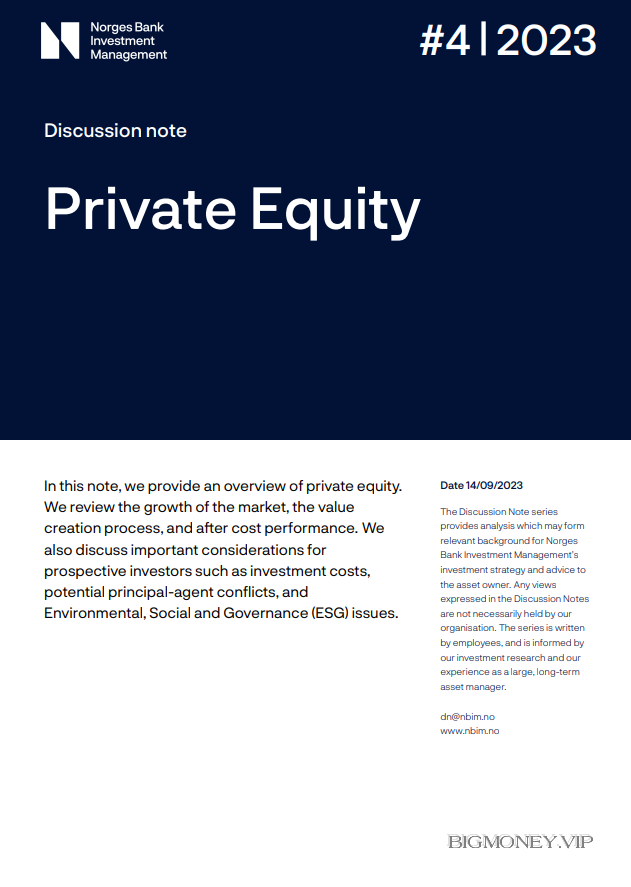Private Equity

1. Introduction
The market for private equity has grown significantly in recent times. Assets under
management have increased more than 12 percent annually since 2010, reaching 7
trillion dollars. At the same time, private equity has become a key part of
institutional investors’ portfolios. Private equity fundraising has risen in line with
assets under management, and the share of investors’ portfolios invested in
private equity has increased steadily over time, reaching more than 7 percent on
average. For the peer group of the Government Pension Fund Global (GPFG), the
average share is more than 9 percent (CEM Benchmarking, 2021).
In this note, we provide an overview of private equity. We begin by exploring the
organisational structure of private equity funds. We then provide an overview of
the current private equity landscape, including developments in both private and
public markets. We show that the rapid growth in the market for private equity has
coincided with a stagnation in the number of companies in public equity markets,
and discuss how these trends have been interpreted in the academic literature.
We evaluate the methods used by private equity funds to increase the value of the
companies they invest in. These methods can be broadly categorised into
implementing change in companies’ financing, governance, or operations.
Historically, changes to companies’ financing, or leverage, was the primary source
of value creation. In recent times, changes to companies’ governance and
operations have been the primary source.
We examine the risk and return of private equity, focusing specifically on the
after-cost performance relative to public markets. We consider buyout, venture
capital, growth equity, and secondary strategies. Standard asset pricing
techniques used to evaluate public markets are not employable in private markets
as returns are observed infrequently and fund valuations can be stale. We
therefore review the various metrics used in the literature and calculate
performance using measures that compare private and public equity cash flows.
We find private equity performance varies significantly based on strategy. Buyouts
have meaningfully outperformed public equity by 3 to 4 percentage points
annually, while venture capital and growth equity have underperformed by 1 to 2
percentage points annually. For buyout funds, we continue to find excess return
after accounting for market risk and other risk factors.
We compare our results with recent academic studies, which use a variety of
different methods and datasets. On balance, our results for buyouts are consistent
with the academic literature. However, the evidence on venture capital is mixed,
and varies based on the sample period and dataset employed. In keeping with the
literature, we find performance is highly dispersed and depends on strategy,
timing, and manager selection. Consequently, the implementation of private equity
and choice of private equity funds requires careful consideration from investors
The note proceeds as follows. We start by outlining the structure and
characteristics of private equity funds, and discuss the development of private
and public equity markets. In section 2, we explain the methods used by private
equity firms to increase the value of the companies in which they invest. In section
3, we estimate the after-cost performance of private equity and compare our
results with the existing literature. In section 4, we review the literature on other
relevant topics for investors considering private equity investments, and section 5
concludes.
Organisation and the fund lifecycle
Private equity refers to investments in the equity of companies that are not publicly
traded. Most investors access private equity by committing capital to funds
established by private equity firms. Private equity funds purchase shares in private
companies or in public companies which they take private. They then aim to
increase the value of these companies through active ownership and governance
with the aim of selling them at a profit at a later stage. Figure 1 shows the most
common fund structure used, and the key entities involved. In this structure the
fund is organised as a limited partnership, with investors as limited partners (LPs)
and the private equity firm as the general partner (GP).
The first entity in the private equity fund structure is the investors, who commit
capital to the fund. As limited partners, investors are not involved in the investment
decision-making of the fund and their liabilities are limited to the capital invested.
However, capital committed by investors is locked in for the duration of the fund’s
life, resulting in less liquidity compared to investments in public markets. Funds are
typically only open to accredited investors and qualified clients, including pension
funds, fund managers, and sovereign wealth funds. These investor groups
currently account for half of the total allocation to private equity investments
today




